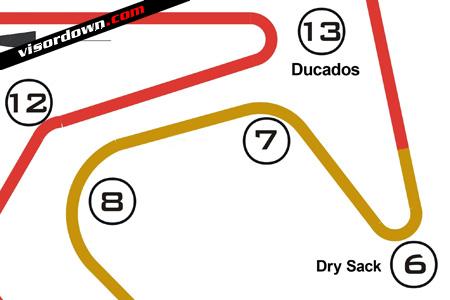Classic corner name at this weekend's Jerez MotoGP
It beats Druids, Redgate and Barn hands down..


THIS news story was meant to run you through a lap of the Jerez circuit according to MotoGP Champion-hopeful Dani Pedrosa. While we were putting the story together we noticed a fantastically named corner, so we thought we'd change the angle of the story a touch. Check out the image above.
If you're planning on doing a trackday at Jerez, you'd do well to print out the below and gaffa tape it to your tank so you can learn it on the ride down:
Main straight and turn 1 and 2, "Expo 92" and "Michelin"
"Jerez is a very difficult circuit on a MotoGP bike. There are only a few straights and little time to rest. The main straight is short, so you reach the braking section of the first corner really quickly. Coming out well from turn 1 is important and the next turn, Michelin, is one of the points of the circuit that allows for good overtaking manoeuvres. It is a right-hand angle where you have to follow the perfect line to get ready for the series of corners coming next."
Turns 3 and 4
"Turn 3 forces you to change the side on the bike, because you come out from turn 2 leaning to the right and have to change quickly to the left to enter turn 3. The straight leading to turn 4 is hardly noticeable and this turn is quite fast."
Turn 5, "Sito Pons"
"The Sito Pons turn is really nice, I like it. The bike is almost flat; first it goes upwards and than it goes down to the longest straight of the circuit. You have to make good use of the track and come out well, because else you might get passed in the following 300 metres due to the slipstreams or in the next braking section."
Turn 6, "Dry Sack"
"After the Sito Pons turn, we face the longest straight of the circuit. It goes downwards and you reach high speeds. The Dry Sack braking section is like "all-or-nothing". You have to brake very well and avoid the other riders passing you through the inside. It is obviously also a good place to overtake your rivals."
Turn 7
"This is a good point to check the condition of your tyres, because you are almost flat in this corner, and when you open the throttle, if the tyres are worn, you skid a lot. It is a fast corner and you are nearly flat."
Turn 8
"This turn is a left-hand hairpin that forces you to lean down a lot and open the throttle really softly. You have to get out well to be able to follow the right line, especially if you have someone behind you, to do the "Nieto" and "Peluqui" turns well."
Turns 9 and 10, "Nieto" and "Peluqui"
"These are two linked right-handers that become a single one. You have to be very precise when entering the first one, because if you make a mistake in the beginning, the rest won't be OK either. And you have to be careful when getting on the intermediate kerb; it is a bit irregular and you are almost lying there."
Turns 11 and 12, "Crivillé" and "Ferrari"
"These are the two most important corners of the Jerez Circuit. It is very difficult to overtake there because you are at more than 200 Km/h, and it's definitely not a good place to crash. After turn 12 there is the angle before the start/finish straight, difficult and very important."
Turn 13, "Ducados"
"It has different lines and it makes a difference whether you arrive there with a rider in front or behind. Moreover, the acceleration when coming out of the corner is crucial in the last lap if you're being followed by other riders. This corner has a difficult entry and exit."
Main straight
"If you come out of the last corner badly you may be overtaken on the finish line. It is a small straight and you hardly have any time to rest on the MotoGP bike. You have to get almost immediately ready to brake for the first corner."

